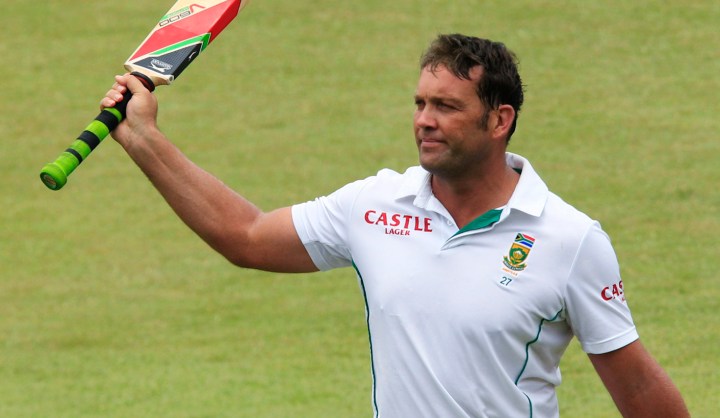Sport
Analysis: The Kallis Conundrum

As King Kallis packs up his mountain of test runs, wickets and catches, the selectors will have a “transformation-sized” headache ahead of them as they attempt to figure the new cake mix combination needed to keep the Proteas at the pinnacle of test match cricket. By STYLI CHARALAMBOUS.
We all knew this day was coming, and yet like the proverbial ostrich head in the sand, we never really wanted to accept that it would happen at all, let alone this soon. His consistently great performances were such that we expected him to carry on performing into perpetuity. In Jacques Henry Kallis’ final soiree in the test arena, he’s once again shown to be the cement in the foundation of the Proteas’ innings, and by scoring a century achieved a feat that other cricketing greats, Bradman, Sobers, Tendulkar or Ponting could not.
So how exactly does one go about replacing the greatest cricketer this country has ever produced?
Since his debut back in 1995, the Proteas have been the recipients of a 2-for-1 special every time he’s walked out in test match whites. With a batting average higher than that of Sachin Tendulkar’s and a bowling average lower than that of Zaheer Khan’s, it was a massive advantage that in his early days kept South Africa competitive and more recently has been central to their rise to the test dominance. Having the initials JHK on the team sheet allowed selectors the flexibility to pick an extra bowling or batting option at their will. To have that option is a luxury, to have it for 18 years, is, well, almost as incredible as his career statistics.
Not only will we miss his steady accumulation of runs, and partnership-breaking wickets, but also those buckets that passed as hands in the slip cordon. So where will the selectors look to now, as they seek to fill the Grand Canyon-sized hole left by Kallis? As with most selection posers of this magnitude, there are a number of strategies selectors could be adopt for a solution.
The first is the “wishful thinking” approach, searching for a like-for-like all-rounder replacement. And despite South Africa producing the majority of the finest all-rounders in history (think Proctor, Rice, Goddard, Greig, D’Oliveira, to name a few) it will be a long time before we see someone of their quality in Proteas whites again, let alone Kallis’.
Perhaps Ryan Mclaren, who has shown on the ODI stage that he has skills with both bat and ball, could be in the running for the job whose description comes with the unenviable annotation of “replacement to the greatest player of our generation”. Mclaren could slot in at number eight after shifting AB de Villiers, Faf du Plessis and JP Duminy up one position. With a first class batting average 30 and three centuries to his name, the Proteas would still be the proud owners of the one of the most talented and importantly, long batting line-ups in test cricket.
An outside and youthful prospect with his hand somewhat in the all-rounder category is Wayne Parnell. Despite not having the batting pedigree of McLaren, the 24-year-old has two List A centuries against his name and has opened the batting for the Warriors and even once for the Proteas ODI team, despite being picked as a bowler. He’s unlikely to be a short-term replacement, but could be long-term project for CSA to mould him into a test candidate all-rounder, with the added benefit of being a left-arm seamer, a variation the Proteas have not had at their disposal in a long time.
An alternative approach to solving the Kallis conundrum is one a little more left-field. Such is the impact of Kallis on the Proteas, that his departure possibly requires not one but two changes to the side, like adding a specialist batsmen to the mix and for the most part, drop the under-performing spinning duet of Imran Tahir and Robin Peterson, to make way for a another seaming option.
If we look back at the Proteas rise to number one, they’ve largely relied on the pace and seam attack to scalp 20 wickets, with both Tahir and Peterson contributing in spurts yet consistently looking like one poor performance away from being dropped. So unless we’re playing on the dustbowls of the sub-continent, it wouldn’t be a bad option to pick another seam option from the likes of Rory Kleinveldt, Kyle Abbot, Marchant de Lange or even Mclaren and Parnell. As for the spinning duties, JP Duminy has shown enough promise to warrant extra responsibility in the test match department, albeit with a lot more hard work required in the nets.
In choosing a straight batting replacement, Dean Elgar’s name is currently the first in line for test matches. As he already has a test hundred to his credit to go with a first class average above 50, his selection is unlikely to raise too many eyebrows. Picking anyone else, would justifiably leave Elgar feeling aggrieved. But this writer would like to see to the brains trust give the exciting Quinton de Kock a bash at number six or seven, with a view to destroying already-demoralised attacks the way Adam Gilchrist used to for that great Australian side. Imagine opposing teams grafting all day to get through South Africa’s top 5, only to find de Kock waiting to smash them around.
In scoring three consecutive hundreds against the bulk of this Indian test team in the ODI series, de Kock wrote his way into the history books. Although some will argue the Indian team were woefully undercooked and didn’t take the chances he offered in the field, he showed more than just glimpses of his X-factor prompting cricketing brains worth their salt talking about an imminent entry to test match cricket for the 21 year-old.
de Kock also comes with the added arsenal of being able to take the gloves from AB de Villiers for the odd relief session if needed, even though the latter’s batting average has soared since taking over the gloves, albeit after a sketchy start. AB de Villiers is now South Africa’s 2-for-the-price-of-1 test match player, and taking full advantage of that will be key to keeping South Africa at the top of the rankings. But with test captaincy, a move up the batting order and the wrong side of thirty not too far away, selectors will need to look at a management programme for the man who’ll now take over the mantle of South Africa’s most talented cricketer. And de Kock may just prove to be central to that plan.
Whichever way the selectors decide to go, expect an extremely challenging transition period that, thankfully, the world’s best test side can afford to carry. If nothing else, at least the Kallis void comes at a time when South Africa can afford it most. DM
Photo: South Africa’s Jacques Kallis acknowledges the applause from the spectators after he got out in his last test appearance during the fourth day of the second cricket test match against India in Durban, December 29, 2013. REUTERS/Rogan Ward




















 Become an Insider
Become an Insider